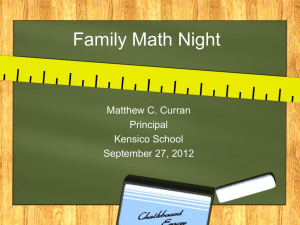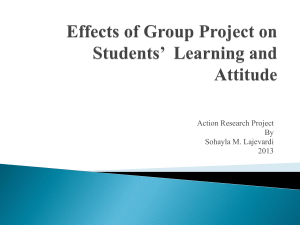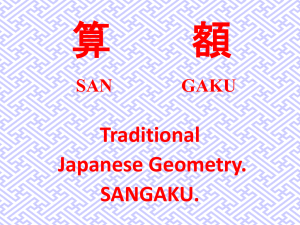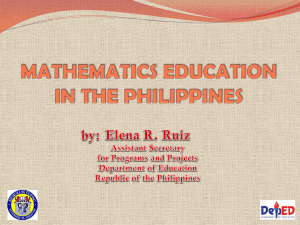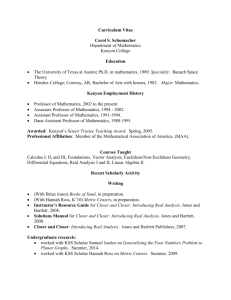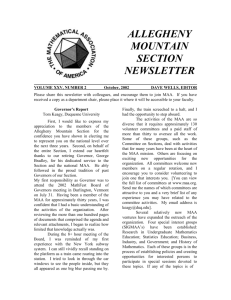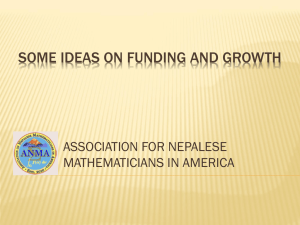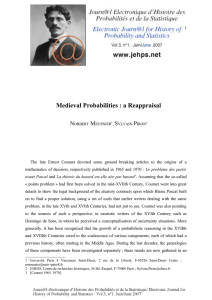PowerPoint - California Mathematics Council Community Colleges
advertisement
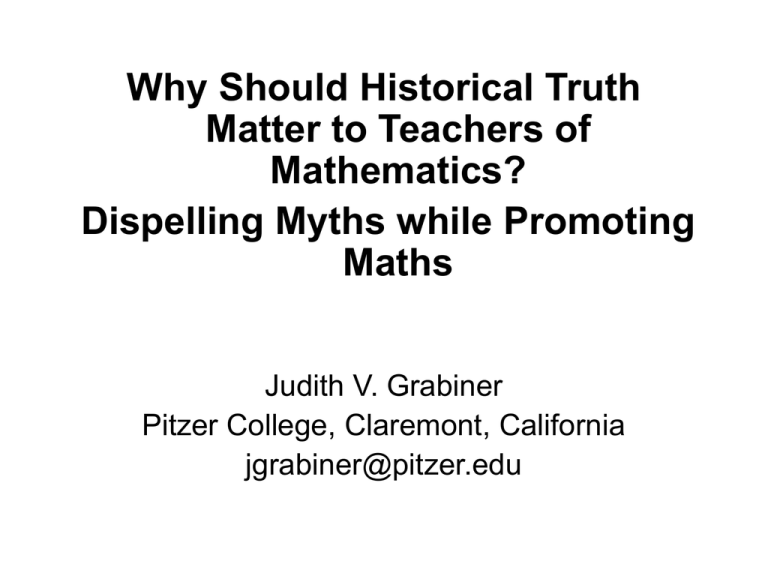
Why Should Historical Truth Matter to Teachers of Mathematics? Dispelling Myths while Promoting Maths Judith V. Grabiner Pitzer College, Claremont, California jgrabiner@pitzer.edu 1. First Myth: The social history of mathematics is easy; just determine what nation or group your mathematician comes from and generalize 2. All modern mathematics comes from Christian men in the Graeco-European tradition. Notable mathematicians of the past who are included on the 2009 MAA Poster, “Women of Mathematics” Hypatia of Alexandria (ca. 355-415) Gabrielle du Châtelet (1706-1749) Maria Gaetana Agnesi (1718-1799) Caroline Herschel (1750-1848) Marie-Sophie Germain (1776-1831) Ada Lovelace (1815-1852) Florence Nightingale (1820-1910) Christine Ladd-Franklin (1847-1930) Sofia Kovalevskaia (1850-1890) Charlotte Angas Scott (1858-1931) Grace Chisolm Young (1868-1944) Emmy Noether (1882-1935) Ann Johnson Pell Wheeler (1883-1966) Dame Mary Cartwright (1900-1998) Mina Rees (1902-1997) Ruth Moufang (1905-1977) Olga Taussky-Todd (1906-1995) Grace Hopper (1906-1992) Emma Lehmer (1906-2007) Cora Ratto de Sadosky (1912-1981) Hanna Neumann (1914-1971) Julia Bowman Robinson (1919-1985) Olga Ladyzhenskaya (1922-2004) Olga Arsen’enva Oleinik (1925-2001) Etta Zubner Falconer (1933-2002) Over 30% of all U. S. Ph. Ds. in math now are women. Biological change? Oh, sure. You can still buy the colorful MAA “Women of Math” poster • http://www.maa.org/pubs/posterW.p df Muhammad ibn Musa al-Khwarizmi (c. 780 – 850) Name Latinized as Algorismus Name then confused with Arithmos Name & method became “Algorithm” _________________________________ His book: Al-kitab al-muhtasar fi hisab al-jabr wa’l’muqabala became “Algebra” The picture illustrates a bow and bowstring, or cord, or (Greek) “chord” The sine is the half-chord Since the sine is the half-chord: Sanskrit: jya - ardha (chord –half) Shortened into jya or jiva Transliterated into Arabic as: jiba RD WTHT VWLS: jaib = bay, inlet, cavity Translated into Latin as: Sinus 3. There wasn’t any real mathematics in the European Middle Ages. After the decline of Greek mathematics, nothing important happened mathematically in Europe until the Renaissance. Merton mean-speed theorem If the velocity is changing uniformly, Distance covered in time t = distance covered by average speed (Vmax+ Vmin)/2 in the same time Stated by William of Heytesbury, 1335, at Merton College, Oxford Diagram is first drawn by Nicole Oresme, 1350 Area under velocity graph = distance covered in time t = distance covered by average speed (Vmax+ Vmin)/2 in the same time Oresme’s diagram Galileo’s diagram, from his epoch-making book Two New Sciences, 1633 1/2 + 2/4 + 3/8 + 4/16 + 5/32 + … k/2k + … Sum? 1/2 + 1/4 + 1/8 + 1/16 + 1/32 +… + 1/4 + 1/8 + 1/16 + 1/32 +… = 1 = 1/2 + 1/8 + 1/16 + 1/32 +… = 1/4 + 1/16 + 1/32 +… = 1/8 + 1/32 +… = 1/16, etc. Right column adds up to 2 So the sum is 2. This solution is due to Richard Swineshead (Suiseth), 14th century, nicknamed “Calculator.” Proof that the harmonic series diverges: Nicole Oresme, 14th Century 1/2 + 1/3 + 1/4 + 1/5 + 1/6 + 1/7 + 1/8 + … = 1/2 + (1/3 + 1/4) + (1/5 + 1/6 + 1/7 + 1/8) + … ≥ 1/2 + (1/ 4 + 1/ 4) + (1/8 + 1/8 + 1/8 + 1/8) + … = 1/2 + 1/2 + 1/ 2 which exceeds any given quantity. + . .. 4. Newton invented the calculus just so he could do his physics. D. T. Whiteside, ed., The Mathematical Papers of Isaac Newton, 8 volumes, Cambridge University Press, 1967 – 1981 The papers on the discovery of the calculus are in Volume I, covering 1664 – 1666 (in Latin – sorry!) 5. Serious statistical thinking in the sciences begins in the natural sciences; the social sciences learned this from natural science and copied it so they’d look scientific. Adolphe Quetelet, 1796-1874 Quetelet: “Curve of possibilities”: 1830s Quetelet, heights of French conscripts, early 19th century (dip in graph greatly exaggerated) 1.57 meters N = 100,000. < 1.57 m, 2275 more than predicted Between 1.570 and 1.624 m, 2114 fewer than predicted 6. The mathematical approach can solve any problem. • Augustin-Louis Cauchy (1789 - 1857) • Auguste Comte (1798 - 1857) Check it out! Victor J. Katz, A History of Mathematics: An Introduction (a 950-page Introduction) Best is the Third Edition, Addison-Wesley, 2009 “Convergence”: Using historical materials to teach mathematics http://mathdl.maa.org/mathDL/46/ History and Pedagogy of Mathematics Newsletter: http://www.clab.edc.uoc.gr/hpm/NewsLetters.htm Let’s ask again: Why should historical truth matter to teachers of mathematics? 1. 2. 3. 4. Examples Mathematical practice In general, truth matters. Mathematics evolves.





